Uttaran Bhattacharya
HUMOTO: A 4D Dataset of Mocap Human Object Interactions
Apr 14, 2025Abstract:We present Human Motions with Objects (HUMOTO), a high-fidelity dataset of human-object interactions for motion generation, computer vision, and robotics applications. Featuring 736 sequences (7,875 seconds at 30 fps), HUMOTO captures interactions with 63 precisely modeled objects and 72 articulated parts. Our innovations include a scene-driven LLM scripting pipeline creating complete, purposeful tasks with natural progression, and a mocap-and-camera recording setup to effectively handle occlusions. Spanning diverse activities from cooking to outdoor picnics, HUMOTO preserves both physical accuracy and logical task flow. Professional artists rigorously clean and verify each sequence, minimizing foot sliding and object penetrations. We also provide benchmarks compared to other datasets. HUMOTO's comprehensive full-body motion and simultaneous multi-object interactions address key data-capturing challenges and provide opportunities to advance realistic human-object interaction modeling across research domains with practical applications in animation, robotics, and embodied AI systems. Project: https://jiaxin-lu.github.io/humoto/ .
Evaluation and Incident Prevention in an Enterprise AI Assistant
Apr 11, 2025



Abstract:Enterprise AI Assistants are increasingly deployed in domains where accuracy is paramount, making each erroneous output a potentially significant incident. This paper presents a comprehensive framework for monitoring, benchmarking, and continuously improving such complex, multi-component systems under active development by multiple teams. Our approach encompasses three key elements: (1) a hierarchical ``severity'' framework for incident detection that identifies and categorizes errors while attributing component-specific error rates, facilitating targeted improvements; (2) a scalable and principled methodology for benchmark construction, evaluation, and deployment, designed to accommodate multiple development teams, mitigate overfitting risks, and assess the downstream impact of system modifications; and (3) a continual improvement strategy leveraging multidimensional evaluation, enabling the identification and implementation of diverse enhancement opportunities. By adopting this holistic framework, organizations can systematically enhance the reliability and performance of their AI Assistants, ensuring their efficacy in critical enterprise environments. We conclude by discussing how this multifaceted evaluation approach opens avenues for various classes of enhancements, paving the way for more robust and trustworthy AI systems.
Shape My Moves: Text-Driven Shape-Aware Synthesis of Human Motions
Apr 04, 2025



Abstract:We explore how body shapes influence human motion synthesis, an aspect often overlooked in existing text-to-motion generation methods due to the ease of learning a homogenized, canonical body shape. However, this homogenization can distort the natural correlations between different body shapes and their motion dynamics. Our method addresses this gap by generating body-shape-aware human motions from natural language prompts. We utilize a finite scalar quantization-based variational autoencoder (FSQ-VAE) to quantize motion into discrete tokens and then leverage continuous body shape information to de-quantize these tokens back into continuous, detailed motion. Additionally, we harness the capabilities of a pretrained language model to predict both continuous shape parameters and motion tokens, facilitating the synthesis of text-aligned motions and decoding them into shape-aware motions. We evaluate our method quantitatively and qualitatively, and also conduct a comprehensive perceptual study to demonstrate its efficacy in generating shape-aware motions.
Speech2UnifiedExpressions: Synchronous Synthesis of Co-Speech Affective Face and Body Expressions from Affordable Inputs
Jun 26, 2024



Abstract:We present a multimodal learning-based method to simultaneously synthesize co-speech facial expressions and upper-body gestures for digital characters using RGB video data captured using commodity cameras. Our approach learns from sparse face landmarks and upper-body joints, estimated directly from video data, to generate plausible emotive character motions. Given a speech audio waveform and a token sequence of the speaker's face landmark motion and body-joint motion computed from a video, our method synthesizes the motion sequences for the speaker's face landmarks and body joints to match the content and the affect of the speech. We design a generator consisting of a set of encoders to transform all the inputs into a multimodal embedding space capturing their correlations, followed by a pair of decoders to synthesize the desired face and pose motions. To enhance the plausibility of synthesis, we use an adversarial discriminator that learns to differentiate between the face and pose motions computed from the original videos and our synthesized motions based on their affective expressions. To evaluate our approach, we extend the TED Gesture Dataset to include view-normalized, co-speech face landmarks in addition to body gestures. We demonstrate the performance of our method through thorough quantitative and qualitative experiments on multiple evaluation metrics and via a user study. We observe that our method results in low reconstruction error and produces synthesized samples with diverse facial expressions and body gestures for digital characters.
* 14 pages, 7 figures, 2 tables
HanDiffuser: Text-to-Image Generation With Realistic Hand Appearances
Mar 04, 2024



Abstract:Text-to-image generative models can generate high-quality humans, but realism is lost when generating hands. Common artifacts include irregular hand poses, shapes, incorrect numbers of fingers, and physically implausible finger orientations. To generate images with realistic hands, we propose a novel diffusion-based architecture called HanDiffuser that achieves realism by injecting hand embeddings in the generative process. HanDiffuser consists of two components: a Text-to-Hand-Params diffusion model to generate SMPL-Body and MANO-Hand parameters from input text prompts, and a Text-Guided Hand-Params-to-Image diffusion model to synthesize images by conditioning on the prompts and hand parameters generated by the previous component. We incorporate multiple aspects of hand representation, including 3D shapes and joint-level finger positions, orientations and articulations, for robust learning and reliable performance during inference. We conduct extensive quantitative and qualitative experiments and perform user studies to demonstrate the efficacy of our method in generating images with high-quality hands.
VaQuitA: Enhancing Alignment in LLM-Assisted Video Understanding
Dec 04, 2023



Abstract:Recent advancements in language-model-based video understanding have been progressing at a remarkable pace, spurred by the introduction of Large Language Models (LLMs). However, the focus of prior research has been predominantly on devising a projection layer that maps video features to tokens, an approach that is both rudimentary and inefficient. In our study, we introduce a cutting-edge framework, VaQuitA, designed to refine the synergy between video and textual information. At the data level, instead of sampling frames uniformly, we implement a sampling method guided by CLIP-score rankings, which enables a more aligned selection of frames with the given question. At the feature level, we integrate a trainable Video Perceiver alongside a Visual-Query Transformer (abbreviated as VQ-Former), which bolsters the interplay between the input question and the video features. We also discover that incorporating a simple prompt, "Please be critical", into the LLM input can substantially enhance its video comprehension capabilities. Our experimental results indicate that VaQuitA consistently sets a new benchmark for zero-shot video question-answering tasks and is adept at producing high-quality, multi-turn video dialogues with users.
Large Content And Behavior Models To Understand, Simulate, And Optimize Content And Behavior
Sep 08, 2023



Abstract:Shannon, in his seminal paper introducing information theory, divided the communication into three levels: technical, semantic, and effectivenss. While the technical level is concerned with accurate reconstruction of transmitted symbols, the semantic and effectiveness levels deal with the inferred meaning and its effect on the receiver. Thanks to telecommunications, the first level problem has produced great advances like the internet. Large Language Models (LLMs) make some progress towards the second goal, but the third level still remains largely untouched. The third problem deals with predicting and optimizing communication for desired receiver behavior. LLMs, while showing wide generalization capabilities across a wide range of tasks, are unable to solve for this. One reason for the underperformance could be a lack of "behavior tokens" in LLMs' training corpora. Behavior tokens define receiver behavior over a communication, such as shares, likes, clicks, purchases, retweets, etc. While preprocessing data for LLM training, behavior tokens are often removed from the corpora as noise. Therefore, in this paper, we make some initial progress towards reintroducing behavior tokens in LLM training. The trained models, other than showing similar performance to LLMs on content understanding tasks, show generalization capabilities on behavior simulation, content simulation, behavior understanding, and behavior domain adaptation. Using a wide range of tasks on two corpora, we show results on all these capabilities. We call these models Large Content and Behavior Models (LCBMs). Further, to spur more research on LCBMs, we release our new Content Behavior Corpus (CBC), a repository containing communicator, message, and corresponding receiver behavior.
Show Me What I Like: Detecting User-Specific Video Highlights Using Content-Based Multi-Head Attention
Jul 19, 2022Abstract:We propose a method to detect individualized highlights for users on given target videos based on their preferred highlight clips marked on previous videos they have watched. Our method explicitly leverages the contents of both the preferred clips and the target videos using pre-trained features for the objects and the human activities. We design a multi-head attention mechanism to adaptively weigh the preferred clips based on their object- and human-activity-based contents, and fuse them using these weights into a single feature representation for each user. We compute similarities between these per-user feature representations and the per-frame features computed from the desired target videos to estimate the user-specific highlight clips from the target videos. We test our method on a large-scale highlight detection dataset containing the annotated highlights of individual users. Compared to current baselines, we observe an absolute improvement of 2-4% in the mean average precision of the detected highlights. We also perform extensive ablation experiments on the number of preferred highlight clips associated with each user as well as on the object- and human-activity-based feature representations to validate that our method is indeed both content-based and user-specific.
* 14 pages, 5 figures, 7 tables
HighlightMe: Detecting Highlights from Human-Centric Videos
Oct 05, 2021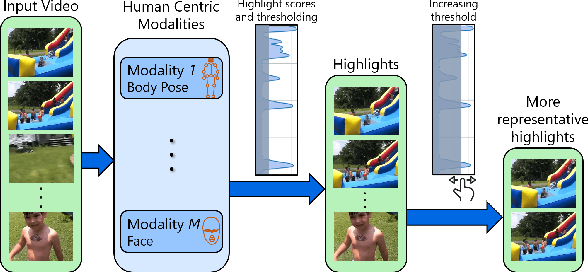
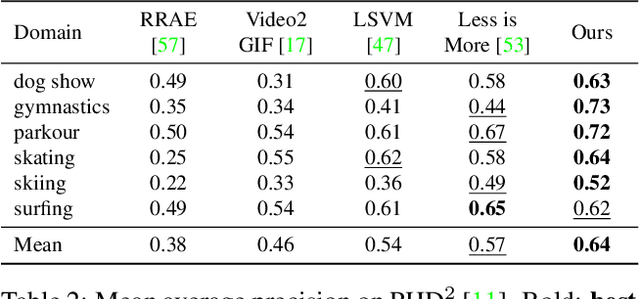
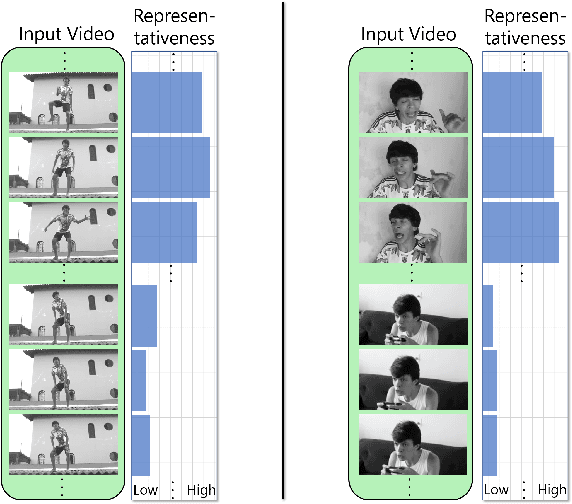

Abstract:We present a domain- and user-preference-agnostic approach to detect highlightable excerpts from human-centric videos. Our method works on the graph-based representation of multiple observable human-centric modalities in the videos, such as poses and faces. We use an autoencoder network equipped with spatial-temporal graph convolutions to detect human activities and interactions based on these modalities. We train our network to map the activity- and interaction-based latent structural representations of the different modalities to per-frame highlight scores based on the representativeness of the frames. We use these scores to compute which frames to highlight and stitch contiguous frames to produce the excerpts. We train our network on the large-scale AVA-Kinetics action dataset and evaluate it on four benchmark video highlight datasets: DSH, TVSum, PHD2, and SumMe. We observe a 4-12% improvement in the mean average precision of matching the human-annotated highlights over state-of-the-art methods in these datasets, without requiring any user-provided preferences or dataset-specific fine-tuning.
Speech2AffectiveGestures: Synthesizing Co-Speech Gestures with Generative Adversarial Affective Expression Learning
Aug 03, 2021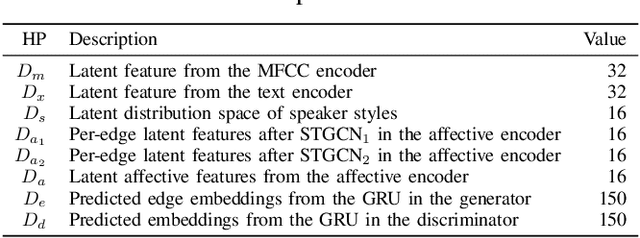
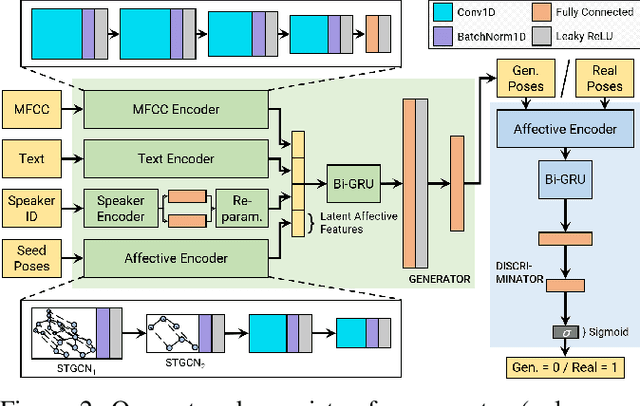
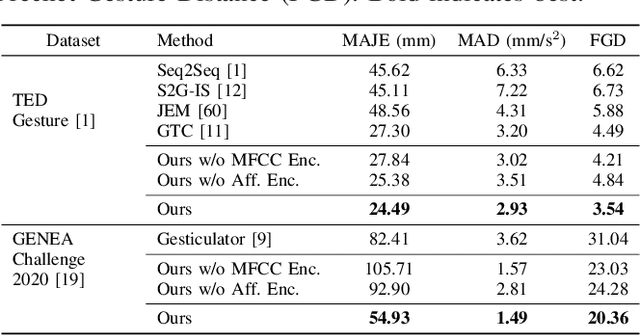
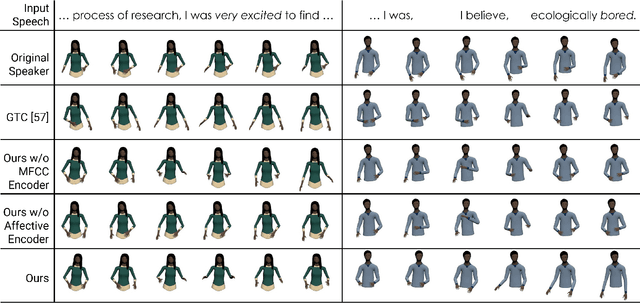
Abstract:We present a generative adversarial network to synthesize 3D pose sequences of co-speech upper-body gestures with appropriate affective expressions. Our network consists of two components: a generator to synthesize gestures from a joint embedding space of features encoded from the input speech and the seed poses, and a discriminator to distinguish between the synthesized pose sequences and real 3D pose sequences. We leverage the Mel-frequency cepstral coefficients and the text transcript computed from the input speech in separate encoders in our generator to learn the desired sentiments and the associated affective cues. We design an affective encoder using multi-scale spatial-temporal graph convolutions to transform 3D pose sequences into latent, pose-based affective features. We use our affective encoder in both our generator, where it learns affective features from the seed poses to guide the gesture synthesis, and our discriminator, where it enforces the synthesized gestures to contain the appropriate affective expressions. We perform extensive evaluations on two benchmark datasets for gesture synthesis from the speech, the TED Gesture Dataset and the GENEA Challenge 2020 Dataset. Compared to the best baselines, we improve the mean absolute joint error by 10--33%, the mean acceleration difference by 8--58%, and the Fr\'echet Gesture Distance by 21--34%. We also conduct a user study and observe that compared to the best current baselines, around 15.28% of participants indicated our synthesized gestures appear more plausible, and around 16.32% of participants felt the gestures had more appropriate affective expressions aligned with the speech.
 Add to Chrome
Add to Chrome Add to Firefox
Add to Firefox Add to Edge
Add to Edge